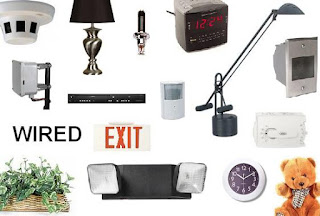Video surveillance systems provide a forever open eye to watch
over property, allowing a sense of safety and security. Cameras attached to a
closed circuit television (CCTV) system send data to a computer or video
recorder for live viewing or later playback. The term closed circuit means that
the images or video recorded by the cameras are not broadcast, but saved on a
storage device. Marie Van Brittan Brown firstly invented the CCTV camera.
Video
cameras`
 How to tell the difference between analogue and digital cameras
depend on the basis of sending analogue or digital signals
to a storage device. In a less technical way, an analog camera is one that uses
film rather than some type of electronic sensor, such as a charge-coupled
device (CCD) or a complementary metal oxide semiconductor chip (CMOS).
How to tell the difference between analogue and digital cameras
depend on the basis of sending analogue or digital signals
to a storage device. In a less technical way, an analog camera is one that uses
film rather than some type of electronic sensor, such as a charge-coupled
device (CCD) or a complementary metal oxide semiconductor chip (CMOS).
Analogue
Video tape recorder can
record analogue signals as pictures directly. If we use tape to record the
analogue signals, the tape must run very slowly to keep continuous operation.
This is because in order to allow a three hour tape to run for 24 hours, it
must be set to run on a time lapse basis which is usually about four frames a
second.
Analog refers to devices in which measurable output quantities,
such as voltage or pressure, represent input data. Let us take a microphone for
voice recording for example. As you speak, fluctuations in air pressure strike
the diaphragm of the microphone, causing corresponding fluctuations in voltage
in an electrical circuit. The voltage is an "analog" of the sound
waves that make up your voice.
Digital
As
shown above, these cameras use a digital signal which can be saved directly to
a computer. "Digital" describes the process by which a signal, such
as the light reflected from a scene, is broken into the binary format so it
represents the scene as a series of ones and zeros. That data is then
transferred to a storage device and reassembled into a representation of the
original scene. The merit of digital is that it have error correction mechanism
which can correct any errors that occur during the data transfer.
As
analogue circuits produce continuous, fluctuating signals, they are more sensitive
to noise or distortion. With analogue, a small change in the signal can result
in a significant change in the output, lots of information is lost in the
process. However, digital signals deal with only one of two values at any given
point in the signal chain, are much more tolerance to noise.
network
A network camera records images and sends the compressed versions
over the network, also called an IP camera. Network cameras used in surveillance systems usually
offer a interface so the camera can be remotely accessed and viewed over the
Internet. The network camera was pioneered in 1996 by Axis Communications,
the worldwide leader in the field. because network cameras are embedded
devices, resolutions are higher than CCTV analogue cameras. A typical analogue
CCTV camera has a PAL (768×576 pixels) or NTSC (720×480
pixels), whereas network cameras may have VGA (640×480 pixels), SVGA (800×600 pixels)
or quad-VGA (1280×960 pixels), "megapixel" resolutions. Network
cameras are a good surveillance solution requiring one network camera, some Ethernet cabling,
and one PC.








